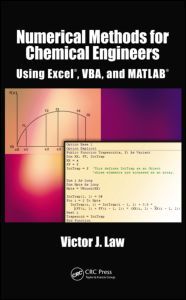Numerical Methods for Chemical Engineers Using Excel, VBA, and MATLAB
Auteur : Law Victor J.

While teaching the Numerical Methods for Engineers course over the last 15 years, the author found a need for a new textbook, one that was less elementary, provided applications and problems better suited for chemical engineers, and contained instruction in Visual Basic® for Applications (VBA). This led to six years of developing teaching notes that have been enhanced to create the current textbook, Numerical Methods for Chemical Engineers Using Excel®, VBA, and MATLAB®.
Focusing on Excel gives the advantage of it being generally available, since it is present on every computer?PC and Mac?that has Microsoft Office installed. The VBA programming environment comes with Excel and greatly enhances the capabilities of Excel spreadsheets. While there is no perfect programming system, teaching this combination offers knowledge in a widely available program that is commonly used (Excel) as well as a popular academic software package (MATLAB). Chapters cover nonlinear equations, Visual Basic, linear algebra, ordinary differential equations, regression analysis, partial differential equations, and mathematical programming methods.
Each chapter contains examples that show in detail how a particular numerical method or programming methodology can be implemented in Excel and/or VBA (or MATLAB in chapter 10). Most of the examples and problems presented in the text are related to chemical and biomolecular engineering and cover a broad range of application areas including thermodynamics, fluid flow, heat transfer, mass transfer, reaction kinetics, reactor design, process design, and process control. The chapters feature "Did You Know" boxes, used to remind readers of Excel features. They also contain end-of-chapter exercises, with solutions provided.
Roots of a Single Nonlinear Equation. Visual Basic® for Applications Programming. Linear Algebra and Systems of Linear Equations. Numerical Differentiation and Integration. Ordinary Differential Equations (Initial Value Problems). Ordinary Differential Equations (Boundary Value Problems). Regression Analysis and Parameter Estimation. Partial Differential Equations. Linear Programming, Nonlinear Programming, Nonlinear Equations, and Nonlinear Regression Using Solver. Introduction to MATLAB®. Appendix A: Additional Features of VBA. Index.
Victor J. Law, Ph.D., FAIChE, FIChemE, CE, initiated a program that was to become the Department of Computer Science at Tulane. During his tenure in computer science, he wrote two textbooks on introductory computer programming. In 1988, Dr. Law returned to the Chemical Engineering Department in order to resume his research career. He has taught classes in process control, transport phenomena, process design, engineering statistics, and numerical methods for chemical engineers. His research has included projects in coastal erosion, methane emissions from rice paddies, thermochemical processes for hydrogen production from water, and butanol production from biomass. Dr. Law is a Fellow of the American Institute of Chemical Engineers; a Fellow of the Institution of Chemical Engineers; a Chartered Engineer in the United Kingdom and Europe; and a Registered Professional Engineer, State of Louisiana.
Date de parution : 04-2013
15.6x23.4 cm
Thèmes de Numerical Methods for Chemical Engineers Using Excel... :
Mots-clés :
Ordinary Differential Equations; VBA Macro; Numerical Methods; Unsteady State Mass Balance; Visual Basic For Applications; Single Nonlinear Equation; Chemical Engineering; Runge Kutta Method; Excel; Initial Guesses; Vba; Euler Method; Matlab; False Position; False Position Method; Keystroke Macro; Parameter Standard Deviations; Goal Seek; dT Dy; Linear Equation; Linear Programming; Straight Line; Backward Euler Method; Van Der Waals Equation; Command Window; Linear Regression; Finite Difference Method; VBA Code; Crank Nicholson Method; Fourth Order RK Method; X4 Y1 Y2 Y3 Y4



